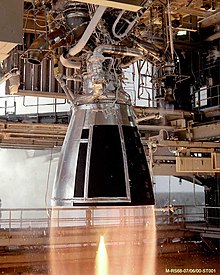Spacecraft propulsion
Spacecraft propulsion is the method that a spacecraft uses to control its movement through outer space. A spacecraft with no means of propelling itself is typically considered derelict.

The problem of propelling a spacecraft has, predictably, existed since spacecraft themselves. Most spacecraft are propelled by rocket engines, which combust an explosive liquid fuel with liquid oxidizer (oxygen in a liquid state) to generate hot gas which expands and propels the spacecraft forward.
Methods
changeMany methods of spacecraft propulsion have been developed and practiced. Most work by accelerating a propellant to a very high speed and ejecting it from the spacecraft through a nozzle.
Chemical rocket
changeA chemical rocket works by mixing an explosive propellant with liquid oxygen and burning it under pressure. This releases a great amount of heat. It results in a rapidly expanding gas. This gas is then funneled out of the rocket's nozzle (usually a bell shape) and off into space.
Ion thruster
changeAn ion thruster works by using static electricity or magnetism to accelerate ions (atoms with an electric charge) to very high speeds, and out of the thruster's nozzle. Ion thrusters make very little thrust but are very efficient.
Nuclear thermal rocket
changeA nuclear thermal rocket heats a propellant with heat from a nuclear reactor before expelling it through a nozzle. Nuclear thermal rockets are currently experimental, but will have decent thrust and high efficiency once put into practice.